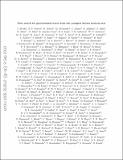First search for gravitational waves from the youngest known neutron star
Author(s)
Barsotti, Lisa; Blackburn, Lindy L.; Foley, Stephany; Harry, Gregory; Hughey, Barbara; Katsavounidis, Erotokritos; Matichard, Fabrice; Mavalvala, Nergis; Smith, Nicolas de Mateo; Stein, Andrew J.; Stein, Leo Chaim; Waldman, Samuel J.; Weiss, Rainer; Corbitt, Thomas R; Evans, Matthew J; Fritschel, Peter K; MacInnis, Myron E; Mittleman, Richard K; Shoemaker, David H; Bodiya, Timothy P.; Donovan, Frederick J; Mason, Kenneth R; Shapiro, B.; ... Show more Show less
DownloadMavalvala_First search.pdf (587.3Kb)
OPEN_ACCESS_POLICY
Open Access Policy
Creative Commons Attribution-Noncommercial-Share Alike
Terms of use
Metadata
Show full item recordAbstract
We present a search for periodic gravitational waves from the neutron star in the supernova remnant Cassiopeia A. The search coherently analyzes data in a 12 day interval taken from the fifth science run of the Laser Interferometer Gravitational-Wave Observatory. It searches gravitational-wave frequencies from 100 to 300 Hz and covers a wide range of first and second frequency derivatives appropriate for the age of the remnant and for different spin-down mechanisms. No gravitational-wave signal was detected. Within the range of search frequencies, we set 95% confidence upper limits of (0.7-1.2) × 10[superscript –24] on the intrinsic gravitational-wave strain, (0.4-4) × 10[superscript –4] on the equatorial ellipticity of the neutron star, and 0.005-0.14 on the amplitude of r-mode oscillations of the neutron star. These direct upper limits beat indirect limits derived from energy conservation and enter the range of theoretical predictions involving crystalline exotic matter or runaway r-modes. This paper is also the first gravitational-wave search to present upper limits on the r-mode amplitude.
Date issued
2010-09Department
Massachusetts Institute of Technology. Department of Mechanical Engineering; Massachusetts Institute of Technology. Department of Physics; LIGO (Observatory : Massachusetts Institute of Technology); MIT Kavli Institute for Astrophysics and Space ResearchJournal
Astrophysical Journal
Publisher
IOP Publishing
Citation
Abadie, J. et al. “First search for gravitational waves from the youngest known neutron star.” The Astrophysical Journal 722.2 (2010): 1504–1513.
Version: Author's final manuscript
ISSN
0004-637X
1538-4357